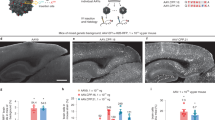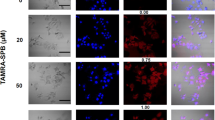Abstract
The JC virus (JCV) may infect human oligodendrocytes and consequently cause progressive multifocal leukoencephalopathy (PML) in patients with immune deficiency. In addition, the virus has also been detected in other human tissues, including kidney, B lymphocytes, and gastrointestinal tissue. The recombinant major structural protein, VP1, of JCV is able to self-assemble to form a virus-like particle (VLP). It has been shown that the VLP is capable of packaging and delivering exogenous DNA into human cells for gene expression. However, gene transfer is not efficient when using in vitro DNA packaging methods with VLPs. In this study, a novel in vivo DNA packaging method using the JCV VLP was used to obtain high efficiency gene transfer. A reporter gene, the green fluorescence protein, and a suicide gene, the herpes simplex virus thymidine kinase (tk), were encapsidated into VLPs in Escherichia coli. The VLP was used to specifically target human colon carcinoma (COLO-320 HSR) cells in a nude mouse model. Intraperitoneal administration of ganciclovir in the tk-VLP-treated mice greatly reduced tumor volume. These findings suggest that it will be possible to develop the JCV VLP as a gene delivery vector for human colon cancer therapy in the future.
This is a preview of subscription content, access via your institution
Access options
Subscribe to this journal
Receive 12 print issues and online access
$259.00 per year
only $21.58 per issue
Buy this article
- Purchase on Springer Link
- Instant access to full article PDF
Prices may be subject to local taxes which are calculated during checkout






Similar content being viewed by others
References
Padgett BL, Walker DL, ZuRhein GM, Eckroade RJ, Dessel BH . Cultivation of papova-like virus from human brain with progressive multifocal leucoencephalopathy. Lancet 1971; 1: 1257–1260.
Chesters PM, Heritage J, McCance DJ . Persistence of DNA sequences of BK virus and JC virus in normal human tissues and in diseased tissues. J Infect Dis 1983; 147: 676–684.
Dorries K, ter Meulen V . Progressive multifocal leucoencephalopathy: detection of papovavirus JC in kidney tissue. J Med Virol 1983; 11: 307–317.
White MK, Gordon J, Reiss K, Del Valle L, Croul S, Giordano A et al. Human polyomaviruses and brain tumors. Brain Res Brain Res Rev 2005; 50: 69–85.
Laghi L, Randolph AE, Chauhan DP, Marra G, Major EO, Neel JV et al. JC virus DNA is present in the mucosa of the human colon and in colorectal cancers. Proc Natl Acad Sci USA 1999; 96: 7484–7489.
Enam S, Del Valle L, Lara C, Gan DD, Ortiz-Hidalgo C, Palazzo JP et al. Association of human polyomavirus JCV with colon cancer: evidence for interaction of viral T-antigen and beta-catenin. Cancer Res 2002; 62: 7093–7101.
Theodoropoulos G, Panoussopoulos D, Papaconstantinou I, Gazouli M, Perdiki M, Bramis J et al. Assessment of JC polyoma virus in colon neoplasms. Dis Colon Rectum 2005; 48: 86–91.
Lin PY, Fung CY, Chang FP, Huang WS, Chen WC, Wang JY et al. Prevalence and genotype identification of human JC virus in colon cancer in Taiwan. J Med Virol 2008; 80: 1828–1834.
Del Valle L, White MK, Enam S, Oviedo SP, Bromer MQ, Thomas RM et al. Detection of JC virus DNA sequences and expression of viral T antigen and agnoprotein in esophageal carcinoma. Cancer 2005; 103: 516–527.
Shin SK, Li MS, Fuerst F, Hotchkiss E, Meyer R, Kim IT et al. Oncogenic T-antigen of JC virus is present frequently in human gastric cancers. Cancer 2006; 107: 481–488.
Zheng H, Abdel Aziz HO, Nakanishi Y, Masuda S, Saito H, Tsuneyama K et al. Oncogenic role of JC virus in lung cancer. J Pathol 2007; 212: 306–315.
Frisque RJ, Bream GL, Cannella MT . Human polyomavirus JC virus genome. J Virol 1984; 51: 458–469.
Goldmann C, Petry H, Frye S, Ast O, Ebitsch S, Jentsch KD et al. Molecular cloning and expression of major structural protein VP1 of the human polyomavirus JC virus: formation of virus-like particles useful for immunological and therapeutic studies. J Virol 1999; 73: 4465–4469.
Chang D, Fung CY, Ou WC, Chao PC, Li SY, Wang M et al. Self-assembly of the JC virus major capsid protein, VP1, expressed in insect cells. J Gen Virol 1997; 78 (Part 6): 1435–1439.
Ou WC, Wang M, Fung CY, Tsai RT, Chao PC, Hseu TH et al. The major capsid protein, VP1, of human JC virus expressed in Escherichia coli is able to self-assemble into a capsid-like particle and deliver exogenous DNA into human kidney cells. J Gen Virol 1999; 80 (Part 1): 39–46.
Chen PL, Wang M, Ou WC, Lii CK, Chen LS, Chang D . Disulfide bonds stabilize JC virus capsid-like structure by protecting calcium ions from chelation. FEBS Lett 2001; 500: 109–113.
Osterman JV, Waddell A, Aposhian HV . DNA and gene therapy: uncoating of polyoma pseudovirus in mouse embryo cells. Proc Natl Acad Sci USA 1970; 67: 37–40.
Slilaty SN, Berns KI, Aposhian HV . Polyoma-like particle: characterization of the DNA encapsidated in vitro by polyoma empty capsids. J Biol Chem 1982; 257: 6571–6575.
Slilaty SN, Aposhian HV . Gene transfer by polyoma-like particles assembled in a cell-free system. Science 1983; 220: 725–727.
Oppenheim A, Peleg A, Fibach E, Rachmilewitz EA . Efficient introduction of plasmid DNA into human hemopoietic cells by encapsidation in simian virus 40 pseudovirions. Proc Natl Acad Sci USA 1986; 83: 6925–6929.
Forstova J, Krauzewicz N, Sandig V, Elliott J, Palkova Z, Strauss M et al. Polyoma virus pseudocapsids as efficient carriers of heterologous DNA into mammalian cells. Hum Gene Ther 1995; 6: 297–306.
Sandalon Z, Dalyot-Herman N, Oppenheim AB, Oppenheim A . In vitro assembly of SV40 virions and pseudovirions: vector development for gene therapy. Hum Gene Ther 1997; 8: 843–849.
Soeda E, Krauzewicz N, Cox C, Stokrova J, Forstova J, Griffin BE . Enhancement by polylysine of transient, but not stable, expression of genes carried into cells by polyoma VP1 pseudocapsids. Gene Ther 1998; 5: 1410–1419.
Krauzewicz N, Cox C, Soeda E, Clark B, Rayner S, Griffin BE . Sustained ex vivo and in vivo transfer of a reporter gene using polyoma virus pseudocapsids. Gene Ther 2000; 7: 1094–1102.
Strayer DS . SV40-based gene therapy vectors: turning an adversary into a friend. Curr Opin Mol Ther 2000; 2: 570–578.
Abbing A, Blaschke UK, Grein S, Kretschmar M, Stark CM, Thies MJ et al. Efficient intracellular delivery of a protein and a low molecular weight substance via recombinant polyomavirus-like particles. J Biol Chem 2004; 279: 27410–27421.
Louboutin JP, Agrawal L, Reyes BA, Van Bockstaele EJ, Strayer DS . Protecting neurons from HIV-1 gp120-induced oxidant stress using both localized intracerebral and generalized intraventricular administration of antioxidant enzymes delivered by SV40-derived vectors. Gene Ther 2007; 14: 1650–1661.
Wang M, Tsou TH, Chen LS, Ou WC, Chen PL, Chang CF et al. Inhibition of simian virus 40 large tumor antigen expression in human fetal glial cells by an antisense oligodeoxynucleotide delivered by the JC virus-like particle. Hum Gene Ther 2004; 15: 1077–1090.
Stokrova J, Palkova Z, Fischer L, Richterova Z, Korb J, Griffin BE et al. Interactions of heterologous DNA with polyomavirus major structural protein, VP1. FEBS Lett 1999; 445: 119–125.
Touze A, Bousarghin L, Ster C, Combita AL, Roingeard P, Coursaget P . Gene transfer using human polyomavirus BK virus-like particles expressed in insect cells. J Gen Virol 2001; 82: 3005–3009.
Ou WC, Hseu TH, Wang M, Chang H, Chang D . Identification of a DNA encapsidation sequence for human polyomavirus pseudovirion formation. J Med Virol 2001; 64: 366–373.
Chang D, Cai X, Consigli RA . Characterization of the DNA binding properties of polyomavirus capsid protein. J Virol 1993; 67: 6327–6331.
Ou WC, Tsai RT, Wang M, Fung CY, Hseu TH, Chang D . Genomic cloning and sequence analysis of Taiwan-3 human polyomavirus JC virus. J Formos Med Assoc 1997; 96: 511–516.
Hirt B . Selective extraction of polyoma DNA from infected mouse cell cultures. J Mol Biol 1967; 26: 365–369.
Mosmann T . Rapid colorimetric assay for cellular growth and survival: application to proliferation and cytotoxicity assays. J Immunol Methods 1983; 65: 55–63.
Shashkova EV, Cherenova LV, Kazansky DB, Doronin K . Avian adenovirus vector CELO-TK displays anticancer activity in human cancer cells and suppresses established murine melanoma tumors. Cancer Gene Ther 2005; 12: 617–626.
Elphick GF, Querbes W, Jordan JA, Gee GV, Eash S, Manley K et al. The human polyomavirus, JCV, uses serotonin receptors to infect cells. Science 2004; 306: 1380–1383.
Pho MT, Ashok A, Atwood WJ . JC virus enters human glial cells by clathrin-dependent receptor-mediated endocytosis. J Virol 2000; 74: 2288–2292.
Ashok A, Atwood WJ . Contrasting roles of endosomal pH and the cytoskeleton in infection of human glial cells by JC virus and simian virus 40. J Virol 2003; 77: 1347–1356.
Qu Q, Sawa H, Suzuki T, Semba S, Henmi C, Okada Y et al. Nuclear entry mechanism of the human polyomavirus JC virus-like particle: role of importins and the nuclear pore complex. J Biol Chem 2004; 279: 27735–27742.
Schaffer DV, Koerber JT, Lim KI . Molecular engineering of viral gene delivery vehicles. Annu Rev Biomed Eng 2008; 10: 169–194.
Matoba T, Orba Y, Suzuki T, Makino Y, Shichinohe H, Kuroda S et al. An siRNA against JC virus (JCV) agnoprotein inhibits JCV infection in JCV-producing cells inoculated in nude mice. Neuropathology 2008; 28: 286–294.
Orba Y, Sawa H, Iwata H, Tanaka S, Nagashima K . Inhibition of virus production in JC virus-infected cells by postinfection RNA interference. J Virol 2004; 78: 7270–7273.
Radhakrishnan S, Gordon J, Del Valle L, Cui J, Khalili K . Intracellular approach for blocking JC virus gene expression by using RNA interference during viral infection. J Virol 2004; 78: 7264–7269.
Monaco MC, Atwood WJ, Gravell M, Tornatore CS, Major EO . JC virus infection of hematopoietic progenitor cells, primary B lymphocytes, and tonsillar stromal cells: implications for viral latency. J Virol 1996; 70: 7004–7012.
Gee GV, Tsomaia N, Mierke DF, Atwood WJ . Modeling a sialic acid binding pocket in the external loops of JC virus VP1. J Biol Chem 2004; 279: 49172–49176.
Acknowledgements
This work was supported by the National Science Council grant NSC97-2320-B-194-001-MY3, Taiwan and Chang Gung Memorial Hospital at Chia-Yi, Chang Gung University grant CMRPG680181, Taiwan.
Author information
Authors and Affiliations
Corresponding authors
Ethics declarations
Competing interests
The authors declare no conflict of interest.
Rights and permissions
About this article
Cite this article
Chen, LS., Wang, M., Ou, WC. et al. Efficient gene transfer using the human JC virus-like particle that inhibits human colon adenocarcinoma growth in a nude mouse model. Gene Ther 17, 1033–1041 (2010). https://doi.org/10.1038/gt.2010.50
Received:
Revised:
Accepted:
Published:
Issue Date:
DOI: https://doi.org/10.1038/gt.2010.50
Keywords
This article is cited by
-
Suppression of bone metastatic castration-resistant prostate cancer cell growth by a suicide gene delivered by JC polyomavirus-like particles
Gene Therapy (2023)
-
Peptide-guided JC polyomavirus-like particles specifically target bladder cancer cells for gene therapy
Scientific Reports (2021)
-
Gene therapy for castration-resistant prostate cancer cells using JC polyomavirus-like particles packaged with a PSA promoter driven-suicide gene
Cancer Gene Therapy (2019)
-
Gene therapy for human glioblastoma using neurotropic JC virus-like particles as a gene delivery vector
Scientific Reports (2018)
-
Synthetic materials at the forefront of gene delivery
Nature Reviews Chemistry (2018)



